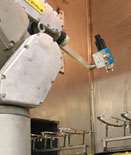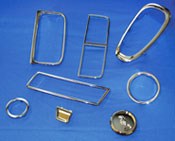PVD + UV Paint = New Business
Automation, other technologies boost finisher
#vacuum-vapor #curing #racking
"What we're good at is taking multiple technologies and combining them to maximize capacity and efficiency."
So says Michael Kreps, president and co-owner of Deco Plas Inc. (Montpelier, OH), summing up his company's operating philosophy. Deco Plas has recently used that ability to combine technologies to develop a process that Kreps believes has big potential to replace chromium electroplating on plastic components for automotive and other applications.
Featured Content
"We were looking at alternatives to traditional chrome electroplating," he recalls. "Over the past two years we've invested probably $500,000 in R&D in that area, and we hit on the PVD technology."
Kreps is referring to Nano-Cr-Chrome, a physical vapor deposition process that can deposit highly reflective chrome and other finishes on a variety of plastic substrates. While Kreps admits that the initial investment in the vacuum chambers needed for the process is a big initial hurdle for many finishers, he also sees another problem.
"Besides initial cost, I think probably the biggest reason more finishers aren't involved in PVD is their lack of experience in painting," he says. "The hardest parts of the process are understanding how to create parts with a Class A surface and controlling your process environment, because you're creating a highly reflective surface.
"With traditional paint, you can buff and do other things to finesse the surface and have a pretty decent first-run capability," Kreps concludes. "With PVD, orange peel and improper coverage are things you just can't hide."
Making the Leap
Launched five years ago in a former Key Plastics facility, Deco Plas currently has 30 employees who operate six paint lines with a total of 13 booths. Part substrate materials include the relatively common ABS and polycarbonate as well as some more exotic materials. "We can finish ABS, PC, conventional nylons, sheet and bulk molding compounds—virtually anything except TPOs and olefins," Kreps says.
So how does painting expertise enable a leap into a technology such as PVD? The Nano-Cr-Chrome parts require a paint base coat and clear coat to develop a durable and long-lasting Class A surface.
"We looked at the kinds of markets we wanted to reach and found some Tier 1 automotive suppliers that supply very high volumes of chrome-plated plastic parts," Kreps explains. "We then set out to find the most cost-effective and consistent way to apply these coatings."
A robotic line was the obvious choice for the part volumes Kreps was anticipating, and small, flexible robots from FANUC America Corp. (Rochester Hills, MI) filled the bill for automated painting. The Fanuc 200iA robots are electric servo-driven and rated for use in hazardous environments such as paint booths. "The miniature robots are very economical to purchase, easy to program, quick, and they don't take up much room," Kreps says.
In keeping with Deco Plas's philosophy of combining technologies to maximize efficiency, the company combined robotic paint application with UV-curable coating materials from Red Spot Paint & Varnish Co. (Evansville, IN). "The coatings we're using in conjunction with Nano-Cr-Chrome are approved for use in automotive, consumer electronics and consumer products applications," Kreps explains.
"So we researched what the best processes would be, then set out to build the best systems to apply the paint," he continues. "We created a Class 10,000 clean room and purchased two chain-on-edge machines that we've converted to give us short cycle times."
As a result of these efforts by Deco Plas's in-house engineering team, the company put together twin paint systems based on plasma cleaning, robotic painting and UV-curable technologies. "We have two identical systems, one to apply base coat and one to apply clear coat," Kreps says. "We installed them in the clean room along with two very large PVD chambers to apply the Nano-Cr-Chrome to large volumes of parts."
The Process
Processing of Nano-Cr-Chrome parts begins with racking of the injection-molded components on tooling designed and built in-house. "Racks are similar to plating racks except we don't need any plastisols on there," Kreps says. "So tooling expenses are low—about a third of plating."
Parts are loaded onto a custom rack, which is then placed on the base coat chain-on-edge machine and subjected to cold plasma cleaning with a system supplied by Plasmatreat North America Inc. (Missassauga, ON). The atmospheric plasma process takes only seconds and cleans the parts at a molecular level. "It also eliminates any possible build-up of static electricity, and if needed it changes the material's surface tension so it wets out properly in the paint process," Kreps explains.
Plasma-cleaned components head directly into the paint booth for robotic application of the UV-curable base coat. This is followed by an ambient flash and a longer heated flash to drive off VOCs, then a series of UV lamps to complete curing.
"Paint cycle time from the time the parts go on the line is 7 min," Kreps says. "So we've dramatically reduced processing time. That's what helps keep costs down."
Racks of cured, base-coated parts are removed from the paint system and placed on a carousel headed to the vacuum chamber for application of the Nano-Cr-Chrome finish. The large chamber size—6 ft wide x 6 ft tall x 8 ft deep—enables processing of thousands of small components in each batch. Deco Plas also invested in cryogenic pump technology that cuts cycle times for the PVD process to 15–20 min.
PVD-coated parts head directly to the second paint line for clear coat application in a process identical to the base coating procedure. Completed parts are then removed from the rack, inspected, packaged and shipped. "Currently parts are manually inspected 100%," Kreps explains. "We're trying to develop a vision system for inspection, but it's a challenge due to the highly reflective part surfaces."
The compact paint systems—each uses only 52 ft of conveyor and takes up less than 200 ft2—plus PVD chambers and all associated equipment are housed in the 2,000 ft2 clean room, one of three in Deco Plas's 77,000 ft2 facility. Installation began in late 2008 and the processes were up and running by mid-2009.
Deco Plas is currently processing 17 different parts on the UV lines. Parts are essentially 2-dimensional components such as automotive trim rings, but will soon include parts with some geometry, such as automotive door handles. A vision system recognizes which part is moving through the line and adjusts the robot program accordingly. "Only the robot path changes; the rest of the process remains the same," Kreps explains. "A single operator monitors the robot and loads/unloads the parts."
The Payoff
According to Kreps, his company's investment into combined PVD and UV paint technologies is paying off not only in terms of new automotive business but also in interest from appliance manufacturers, consumer electronics suppliers and other potential customers.
"The response has been very good," he says. "We're even bringing business back from China because we're not only cost-competitive, we have a cost advantage." Kreps says the company already has three jobs that were being chrome electroplated in China and is working on more.
Nor is Deco Plas standing pat. The company continues to work on new technologies that will enable it to apply the PVD process to a wider variety of part geometries and sizes.
"Next up is a non-UV-curable base coat for Nano-Cr-Chrome parts that we're developing with two paint suppliers," Kreps says. "This technology would allow us to run PVD parts on all seven of our paint lines. We've already done some testing of traditional 2K clear coats over the Nano-Cr-Chrome." Deco Plas has also developed a variety of PVD finishes, including stainless steel and black chrome, he adds.
Kreps acknowledges that the investment into PVD technology and the new paint lines to support it was risky, especially in the current economic climate. But he expects Nano-Cr-Chrome to be the biggest segment of Deco Plas's business going forward. "We made a significant investment, but we did it frugally," he says. "As an entrepreneur, you have to take some risks. It's how you build the future, and this combination of technologies—plasma cleaning, PVD, miniature robots and UV curing—lets us give customers a high-quality product with competitive pricing."
RELATED CONTENT
-
Zinc Electroplating
Choosing the best process for your operation.
-
Cleaning, Pretreatment to Meet Medical Specs ISO 13485 or FDA 21 CFR820
Maximilian Kessler from SurTec explains new practices for industrial parts cleaning, metal pretreatment and decorative electroplating in the medical device industry.
-
Stripping of Plated Finishes
The processes, chemicals and equipment, plus control and troubleshooting.





















